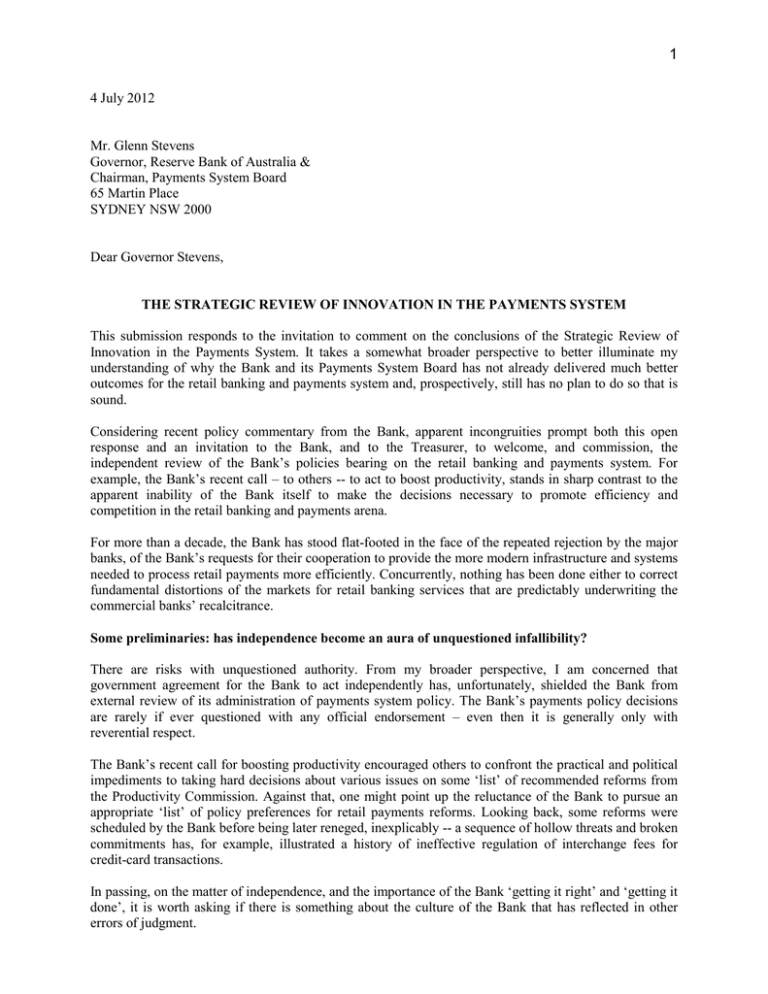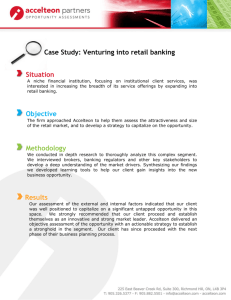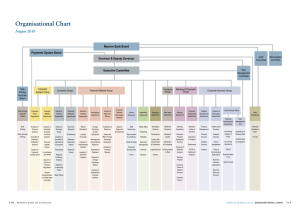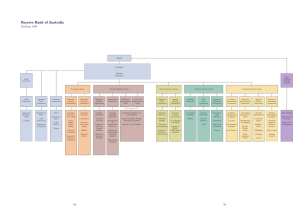1
advertisement

1 4 July 2012 Mr. Glenn Stevens Governor, Reserve Bank of Australia & Chairman, Payments System Board 65 Martin Place SYDNEY NSW 2000 Dear Governor Stevens, THE STRATEGIC REVIEW OF INNOVATION IN THE PAYMENTS SYSTEM This submission responds to the invitation to comment on the conclusions of the Strategic Review of Innovation in the Payments System. It takes a somewhat broader perspective to better illuminate my understanding of why the Bank and its Payments System Board has not already delivered much better outcomes for the retail banking and payments system and, prospectively, still has no plan to do so that is sound. Considering recent policy commentary from the Bank, apparent incongruities prompt both this open response and an invitation to the Bank, and to the Treasurer, to welcome, and commission, the independent review of the Bank’s policies bearing on the retail banking and payments system. For example, the Bank’s recent call – to others -- to act to boost productivity, stands in sharp contrast to the apparent inability of the Bank itself to make the decisions necessary to promote efficiency and competition in the retail banking and payments arena. For more than a decade, the Bank has stood flat-footed in the face of the repeated rejection by the major banks, of the Bank’s requests for their cooperation to provide the more modern infrastructure and systems needed to process retail payments more efficiently. Concurrently, nothing has been done either to correct fundamental distortions of the markets for retail banking services that are predictably underwriting the commercial banks’ recalcitrance. Some preliminaries: has independence become an aura of unquestioned infallibility? There are risks with unquestioned authority. From my broader perspective, I am concerned that government agreement for the Bank to act independently has, unfortunately, shielded the Bank from external review of its administration of payments system policy. The Bank’s payments policy decisions are rarely if ever questioned with any official endorsement – even then it is generally only with reverential respect. The Bank’s recent call for boosting productivity encouraged others to confront the practical and political impediments to taking hard decisions about various issues on some ‘list’ of recommended reforms from the Productivity Commission. Against that, one might point up the reluctance of the Bank to pursue an appropriate ‘list’ of policy preferences for retail payments reforms. Looking back, some reforms were scheduled by the Bank before being later reneged, inexplicably -- a sequence of hollow threats and broken commitments has, for example, illustrated a history of ineffective regulation of interchange fees for credit-card transactions. In passing, on the matter of independence, and the importance of the Bank ‘getting it right’ and ‘getting it done’, it is worth asking if there is something about the culture of the Bank that has reflected in other errors of judgment. 2 Among other things, it is now reasonably clear that the rather badly mishandled deregulation of the Australian banking system in the 1980s set the scene for a local banking crisis around the end of that decade; concurrently the Bank went along with an always flawed consensus on the prudential supervision of banks, an approach now seen as a precursor to a global banking crisis. In this latter context, the Bank blithely presented itself, in 2006, as well aware of the risks of instability attending a global asset price bubble while independently deciding that dealing with it was not among the Bank’s allocated responsibilities. Some of these shortcomings were common to central bankers generally -- an international brotherhood of ‘independent’ central bankers similarly accorded some aura of infallibility. One inference surely is the importance of avoiding any such ‘hands off’ aura insulating the Bank from effective public scrutiny. A different question concerns the standing exemption of the Bank from periodical reviews of its performance as a major national policy agency. Even if one readily concedes a case for immediate independence about setting interest-rates in a well integrated global economy, it takes to an extreme any such entitlement to exempt the Bank and its Payments System Board from external review of payments policy decisions. As to the conduct of an independent review, it is now clear that this task is beyond the competence of committees of parliamentary backbenchers -- nor is it appealing either to consider processes of the kind conventionally recognized as the ‘Campbell’ and Wallis’ committees: useful as these ‘inquiries’ may have been to packaging and selling conclusions broadly pre-agreed, they were neither independent nor particularly insightful. In short, there is now a sound case for, at least, the Bank’s policy advice and decisions on retail banking and payments policy matters to be reviewed, possibly by the Productivity Commission or a comparably independent and competent panel separately convened. Reforming the retail payments system: “hope is not a strategy” A history of the Bank’s efforts to reform the retail payments system extends over the past 30 years generally, and the past decade in particular. This history is ample testimony to the adage that hopeful good intentions are not enough – especially when the dependent hope is that powerful commercial banks would voluntarily give up the most profitable outcomes for themselves. The conclusions of the Bank’s strategic review of innovation in the retail payments system are another very welcome statement of Australia’s needs, for infrastructure and complementary service standards, to provide a better retail payments system. Being still prospective, and still hopeful, however, these objectives only underscore the opportunity lost over the past decade as flawed regulation and failed markets befuddled payments policy success. What is presented now, as a list of things to do, is substantially just a recast of the same things that the Bank has been wanting done for a decade and more -- and which banks have repeatedly refused to do and will still have no incentive to do, unless and until the market environment is reformed. In short, lessons not learnt, this renewed action-plan again reduces to a worn list of pious hopes floating in the ether without any complementary commitment by the Bank likely to realize them. The Bank can hardly expect the community to wait in joyful hope for four or five years more before disappointment dawns again. It is simply unreasonable for the Bank to proceed this time without also acting decisively to ensure competitive market forces are also working to better align the commercial interests of the banks with the public interest. Put differently, why would the major banks agree to co-operate contrary to their commercial interests when the self same regulator, the Bank, asking them to do so, leaves in place the corrupted commercial incentives clearly telling them not to? 3 Policy unchanged, the banks will do again what they have done for decades -- stand the Bank to ridicule by first promising to co-operate, while arguing for a longer agreed schedule, then pleading unavoidable delays, before ultimately saying that it is not in their individual or collective commercial interest to deliver what was ‘promised’. At some point this looks like a game of ‘stop it, I like it’. Where, over the past fifteen years, is the evidence of the Bank’s competent, resolute, intelligent and politically independent determination to properly reform the retail payments system and otherwise explain why it has not achieved its objectives? My recollection, from 1996, is that the Bank, then long responsible for the Australian Payments System Council and also still Chairman of the Australian Payments Clearing Association, did not even make a substantial, published, submission to the Wallis Committee on retail payments system matters. ..………… and, apparently, little has changed: the Bank remains effectively mute, hands tied. Market corrections pre-requisite to reforming the payments system The prospects for reforming the retail banking and payments system as the Bank would like, remain bleak unless some dominant, distorting and corrupting market forces are displaced to accommodate a more conducive market environment. Put differently, what would be prominent focal points of an independent review of the present functioning of the retail banking and payments markets? The following briefly reprises three themes in submissions put before various studies, inquiries and reviews conducted by the Bank over the past fifteen years – promoting user-pays pricing; managing cartel-like monopolization and facilitating the displacement of the tangibles, cash and cheques. - ‘free banking’ The single most important influence corrupting the efficiency of the retail payments system has been, and remains, the inappropriate funding, effectively from the public purse, underwriting ‘free banking’ for the household community. One would have expected an independent Reserve Bank to make that patently clear and, however politely but persistently, to openly press for both the community acceptance and political commitment needed to stop it. Withdrawing this subsidy would be temporarily contentious but, if properly explained, it could hardly be resisted on any sensible basis. Why is government subsidizing – to the tune of $ billions annually -- the major banks capacity to operate the retail payments system, not only inequitably and inefficiently, but in a way that effectively precludes any substantial competitor emerging with durable prospects of success? What has the Bank ever said about the nonsense of ever doing it and not stopping it? Does the community – or a succession of Treasurers – yet have any proper understanding of the tax-free barter entrenched in retail banking and the consequences that compromise the productivity of the retail banking industry? In short, banks holding deposits in transaction accounts, on which no material interest is paid, use the earnings on the investment of those funds to cover costs of providing underpriced and free transaction services: the effective subsidy, from the public purse, is the personal income tax not paid on the undeclared, non-cash income-in-kind benefit given to depositors. If this subsidy were removed, and banks recovered more of their costs with explicit prices for transaction services, customers would have stronger incentives to use the most cost effective service and not overuse more expensive ‘free’ services, particularly cheques. [Managing the redundancy of the ‘cheque’ is a sensitive social issue but one well within reach of a banking system more inclined to promote acceptable alternatives.] 4 The current low interest environment offers a unique opportunity to correct this fundamental flaw and withdraw the subsidy. Not only would user-pays pricing of bank transactions deliver a substantial productivity dividend but a couple of $ billions of extra tax revenue collected on newly paid interest (or its newly declared income-in-kind equivalent) would be available to be spent more usefully, even allowing the need to then draw directly on the budget to subsidize banking services to the needy dependent on social security. [A community that can cope with a ‘new’ GST and a ‘new’ carbon tax can surely be persuaded to see the sense of paying less, but directly, for their banking services rather than continuing to pay more, but in obscure ways hidden from them.] ……….. and, lest we forget, leaving this corrupting flaw in place in the 15%+ interest rate environment of the 1980s, made a very irresponsible contribution to the banking excesses eventually resulting in the wholesale ‘failure’ of newly licensed foreign bank subsidiaries along with all, then substantial, stateowned banks. It is no wonder we have only four major banks and no prospect of another – and even two of them nearly came to grief in the early 1990s. - managing monopolistic pricing of card transactions The second most important impediment to the proper functioning of the retail payments system has been the consequences of banks taking unnecessary and excessive ad-valorem interchange fees for credit card transactions -- a practice which corrupts the market for bank card transactions generally. Inexplicable then, and still never explained, was the Bank’s decision in August 2002 to renege on a commitment, published in December 2001, to abolish interchange fees on credit card transactions. Whatever, that commitment to outlaw ad-valorem interchange fees for credit card transactions would be best resurrected. What we got instead of ‘zero’ was an average interchange fee capped at 0.5% of purchase values (half the prevailing prior average rate) – but, at 0.5%, the rate was still too high to discourage the sensible substitution of debit cards for credit cards. Some years later, after threatening banks with a further reduction in this capped ad-valorem interchange fee, then clearly still excessive, the threat came to naught even though the banks again failed to deliver the compensating systemic reforms asked for. In the event, the regulated interchange fee for credit card transactions still stands at an excessive average level of 0.5% [a level incidentally at odds with the spirit of the Bank’s recent decision to restrict merchant surcharges on card transactions to the actual costs incurred by merchants]. The unfortunate consequences of this regulatory forbearance for the productivity of the retail banking sector, are both already extensive and still unfolding – to say nothing of the ongoing excessive profitability of the credit card schemes to participating banks along the way. It is, moreover, not clear that continuing damage to the national interest can be arrested and repaired. The starting point for this major policy mistake was the failure to understand that the continued separate existence of credit cards became just a contrivance once the very same physical card could also embody the superior, real-time functionality as a point-of-sale debit card linked to a deposit account. Allowing banks to take a 0.5% commission, on credit card sales alone, saw banks predictably promoting their more profitable use while withholding from debit cards the necessary functionalities – an overdraft facility and over-the-phone purchases etc – needed to be competitive. As well, by charging explicitly for debit card transactions, but presenting credit card use as ‘free’, the incentive to use credit cards was reinforced. Taken together, and measured against the public interest, these were collectively monopolistic and very deliberate acts of commercial bastardry that should never have been tolerated by the Bank in the first place let alone permitted to run on to this day. 5 The tragedy of errors still unfolding has seen the international scheme promoters, Visa and MasterCard (VMC), render redundant the local banks’ eftpos operations, very probably terminally, while newly maneuvering to further enhance the exclusive functionalities of their look-alike, run-alike credit-card schemes. Credit cards now have pole-position in the battle for the spoils as cash becomes ever more redundant in the wake of more conveniently faster ‘no PIN/no signature’ and ‘tap-and-go’ transaction options at point of sale for credit cards only. There is an emerging risk of Australian payments system regulators becoming subordinate authorities to VMC and more generally impotent in managing a major market for retail electronic payments. The authority of the Bank in this arena needs to be re-established and proscribing ad-valorem interchange fees for domestic credit card purchases would be a useful start. Bringing Visa and MasterCard within the confident regulatory reach of the Bank and the Payments System Board would be another – as would a reminder to banks with Australian licenses to stand more clearly for the public interest in the national interest. - the continuing need for cash does not include either $50 or $100 notes The actual tipping point has already passed, apparently unnoticed, but Australian now has a central bank note-issuing authority embroiled in a very problematic business – issuing $50 and $100 bank notes which are now better regarded as bearer-bond investments for age-pensioners than circulating ‘currency’. One persuasive illustration of the problem is the marked difference in the per-capita holdings of currency notes as between Australia and New Zealand. In broad terms the average value of notes held by New Zealanders is about one third of the $A2, 000 held by Australians -- almost all of which, by value, is in the $50 and $100 denominations. An obvious explanation for the difference – means-test free agepensions in New Zealand -- similarly obviously points to the benefits some age-pension recipients in Australian unfairly take by holding undeclared assets as these hoards of bearer-bonds masquerading as $100 banknotes reported as being ‘in circulation’. As a policy issue this has all been a bit inconvenient and one which the Bank has, for years, been plainly not happy to see identified and discussed. Nonetheless it is an issue growing in importance and one that will become ever more contentious – it is a public-policy problem for which the Bank could have, and should have, made a better fist of managing. There are a number of options open. One would see the responsibility for the note issue returned to the Treasury so that the possible attraction, to the Bank, of having first call on the $1.5 billion+ p.a. profit from an over-inflated note issue, does not compromise the Bank’s inclination to better manage the note issue in the national interest. This reform might similarly sensibly work to bring the day-to-day funding of the Bank more clearly within the normal purview of government budgetary decisions. There is a lot to be said for that and the attendant accountability. That change alone would, however, not address the problem of a grossly inflated currency issue disguising a very substantial dead loss to the national coffers – currency hoarders may not get the 4% p.a. interest, that becomes profit on the note issue, but, being only old and not at all silly, these hoarders are almost certainly taking a much higher return on their bearer bond investments as unfairly claimed entitlements to higher pension payments. One relevant policy question then, is about the Treasury having a stronger incentive to better balance the net costs to revenue against the illusory sense of continuing to issue $50 and $100 notes. While withdrawing $50 and $100 notes from circulation would be an intriguingly contentious proposal, and most certainly should never be done in any way precipitously, it is a proposal with both merit now and a longer term sense of inevitability -- especially as the retail payments system becomes progressively more exclusively electronic for making payments of any substantial value. A 5-year plan would be sensibly credible. 6 What would remain in circulation are coins and a modestly expanded issue of currency notes in the $10 and $20 denominations: there is every reason to expect that a national currency issue of this character would soon be adequate to meet the reasonable needs of a community ever more exclusively making substantial payments electronically. Continuing, though reduced, incentives to hold bulky hoards of $20 notes would be further dampened if notes older than five years were only be redeemable at a progressively larger discount to their face value. The prospect of gently restructuring the currency issue in this way would have the additional advantage of strengthening the business case for a new national electronic payments clearing hub in addition to the domestic and international payment networks of Visa and MasterCard operating independently but in association with Australian banks. It is about time to take a couple of short preparatory steps of faith towards the inevitability of conventional cash currency eventually being essentially redundant and similarly stepping away from what was a currency-issue responsibility now become an arrangement irresponsibly facilitating misbehaviour. Concluding note One could go on and on in more detail and across a broader range of issues. For the moment, I rest my case. The next sensible step, to my mind, is for the government to give the Productivity Commission, or a separately convened panel of comparable competence and independence, a brief to assess whether the operations of Australia’s retail banking and payments system are reasonably consistent with the public interest and otherwise advise how any shortcomings might best be made good. Yours sincerely, Peter Mair 2/84 Kurrajong Street Windang NSW 2528





